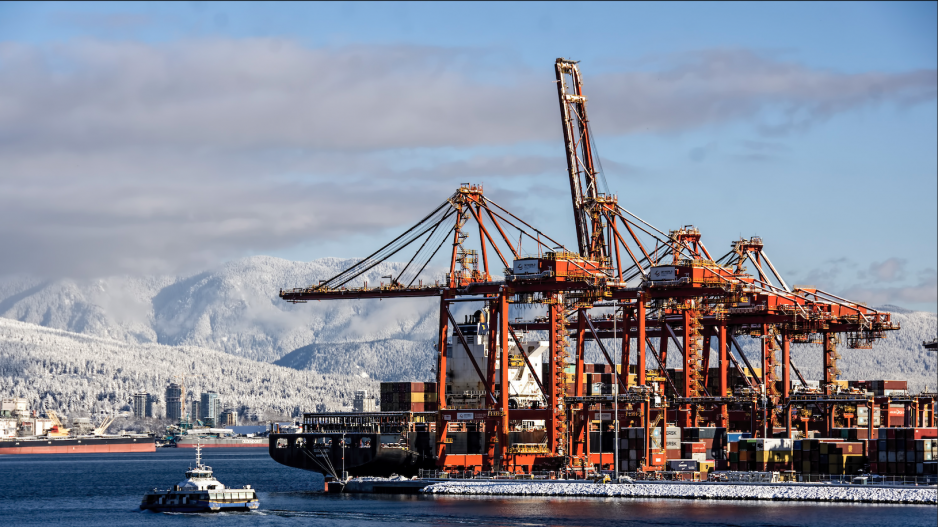West Coast ports continue to recover from pandemic-induced cargo congestion, but is that recovery shifting concerns from too much business to too little?
Last summer, the Port of Vancouver was struggling to reduce delays in loading and unloading cargo and long wait times for ships to get berth time.
Rail dwell times, a measurement of how long a ship’s containers take to be offloaded at the dock and loaded onto rail cars, were approaching seven days compared with the Port of Vancouver’s 2.5 to three-day target, and close to 30 per cent of container ships were being forced to wait at anchor for terminal berth space.
Vancouver was not alone in suffering from port congestion. The contagion was raging up and down North America’s West Coast.
For example, at the height of the pandemic economy’s supply chain dysfunction, cargo logjams at the Los Angeles-Long Beach port complex were forcing up to 90 container ships per day to wait for berth space.
Ports servicing the transpacific trade loop shared several cargo congestion factors. They ranged from a boom in North American consumer goods demand sparked by the pandemic, sporadic shutdowns of Chinese factories resulting from the Chinese Communist Party’s zero-COVID policy and an overall inability of North American supply chains to handle the sudden shift to goods from services.
Added to the Port of Vancouver’s cargo woes were floods and wildfires in 2021 that knocked out rail lines and other transportation arteries for weeks. The port has yet to fully recover from those disasters.
But cargo congestion and delayed transit times for goods being shipped from China to the West Coast have been easing since 2022’s second half.
Weaker consumer demand, 2023’s early Chinese New Year and inflation that has fanned the flames of recession have contributed to that easing.
Peter Xotta, the Vancouver Fraser Port Authority’s vice-president of operations and supply chain, said interest rate hikes and other factors in the current inflationary economy have slowed cargo demand to the point that “things seem to be heading back into balance.”
He noted that container freight rates have dropped significantly, which is a key indicator of global shipping demand.
Shifl, a New York-based digital freight forwarding company, reported in late December that the spot rate for moving a 40-foot container from China to North America’s West Coast had dropped to US$2,361. A year earlier, that rate was hovering around US$20,000.
Xotta added that, while the slowdown has eased port congestion, it is still not back to pre-pandemic fluidity.
“Two days ago, we had no container vessels at anchor. This morning we have two, but the vast majority of container vessels now are going directly to berth. So, it’s well below that 30 per cent that we had previously.”
Part of the drop in transpacific traffic and supply chain congestion can be attributed to major shipping lines managing capacity by cancelling sailings.
DBRS Morningstar noted in a late January report that the three major container shipping alliances had cancelled 27 per cent of their scheduled sailings in 2023’s first seven weeks.
The global credit rating agency added that, in the four weeks leading up to 2023’s Chinese New Year, the China-West Coast cargo volumes affected by cancelled sailings were more than six times what they were in the same period in 2019.
Drewry, a U.K.-based shipping consultancy, reported that soft market demand had resulted in a total of 98 sailings being cancelled on major trade routes between March 6 and 10.
Some older container ships are being scrapped this year to reduce overall capacity, but an estimated seven million 20-foot-equivalent units (TEUs) of new container ship capacity have been ordered. That represents 27 per cent of the total global fleet, and much of that new capacity is scheduled to be delivered this year and next.
Lower supply chain congestion also increases shipping-line capacity.
But while container terminal congestion is easing, freight movement fluidity has yet to recover fully further along Canada’s Asia-Pacific supply chain.
Port of Vancouver rail dwell times are still around six days. Xotta said the target for the port is closer to three days.
He pointed to inventory levels in the broader distribution network, especially in key hubs such as Toronto and Montreal, as one of the reasons for the current supply chain inefficiency.
“Retailers,” he said, “are sitting on inventory that is not moving as quickly as they would like, in part because of economic decline. So, it’s not that our terminals are struggling. It’s that they’re having a hard time evacuating all the containers to the eastern destinations. Because of that … this pig is working its way through the python, and it’s getting to the other end now.”
That economic decline is expected to slow maritime trade growth significantly this year and next. The United Nations Conference on Trade and Development (UNCTAD) projects it to drop to around 2.1 per cent annually between 2023 and 2027. That annual growth averaged closer to 3.3 per cent during the previous three decades.
A drop in trade on the transpacific and other major global trade lanes could mean reduced profitability for container and other port terminals.
Inbound container volume to West Coast ports was down 19 per cent in December compared with the same time in 2021, according to data compiled by container shipping analyst John McCown, who pointed out that the decrease was the fifth straight month of double-digit percentage declines for North America’s West Coast.
Drewry noted in a February report that weaker global demand and lower port congestion have eroded port and terminal profitability, in part because less congestion means fewer container storage charges, which contributed significantly to container terminal revenue during the worst of the supply chain congestion.
That revenue and the overall stock value of major ports and terminals around the world face what Drewry noted were significant downside pressures from “the deteriorating macroeconomic outlook, restrictive monetary policy, high inflation and the ongoing Russia-Ukraine war.”




